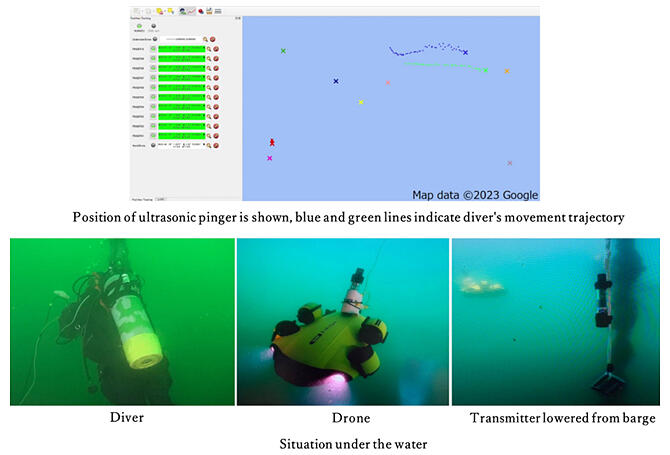In August, KDDI and KDDI Research Inc. developed an underwater acoustic positioning device that can locate multiple workers and divers underwater and conducted a demonstration experiment on the coast of Numazu City, Shizuoka Prefecture. With this device, the positions of a total of 10 objects (ultrasonic pingers), including two underwater divers and one underwater drone, were measured every second by a single receiver, and each position was successfully visualized and observed. The demonstration experiment used "Super-Short Baseline" (SSBL) acoustic positioning technology, which can determine the location of an object from the phase difference and arrival time of ultrasonic waves emitted from the object.
The success of the experiment indicates that the position and movement of divers and underwater drones can be determined even from land. Using this technology to feedback position information and movements to divers is expected to improve the safety and efficiency of underwater activities. Through this, both companies will promote DX (Digital Transformation) for activities in water bodies, including the ocean, such as monitoring of marine resources, underwater infrastructure inspection, and even leisure diving.

Provided by KDDI Research, Inc.
The need for underwater inspections is increasing in port projects and fisheries in Japan; however, these underwater activities involve the risk of accidents. The two companies believe it is crucial to know the location and ensure safety during underwater activities. Therefore, they have been studying countermeasures to dispel concerns about underwater activities, for search and rescue in the event of an accident, and to enable multiple underwater workers and underwater drones to work more efficiently.
The results of this research helped the two companies develop an underwater acoustic positioning device that can observe the position of multiple objects (ultrasonic pinger) in 1 s with a single receiver.
In the demonstration experiment, 10 ultrasonic pingers were submerged at depths of 2 to 30 m. By shifting the transmission timing of each ultrasonic transmitter by 0.1 s and setting the receiver's reception timing to be the same, the positions of the 10 units could be calculated and observed every second.
They also attached three of the 10 ultrasonic pingers to two divers and one underwater drone, successfully visualizing the positions of the divers and underwater drone every second. Although measurements using sound waves are greatly affected by reflections from the sea surface and other sources, the knowledge that has been accumulated on underwater acoustic positioning technology has enabled the companies to significantly reduce these effects and confirm that the new method works in actual sea areas.
Future development will include improving positional measurement performance and expanding the number and range of measurement targets to support DX for safer and more efficient monitoring of marine resources and underwater infrastructure inspections. In addition to port operations and fisheries, the companies will consider using the technology for leisure activities such as scuba diving, aiming to solve social issues in a variety of scenarios.
This article has been translated by JST with permission from The Science News Ltd. (https://sci-news.co.jp/). Unauthorized reproduction of the article and photographs is prohibited.




